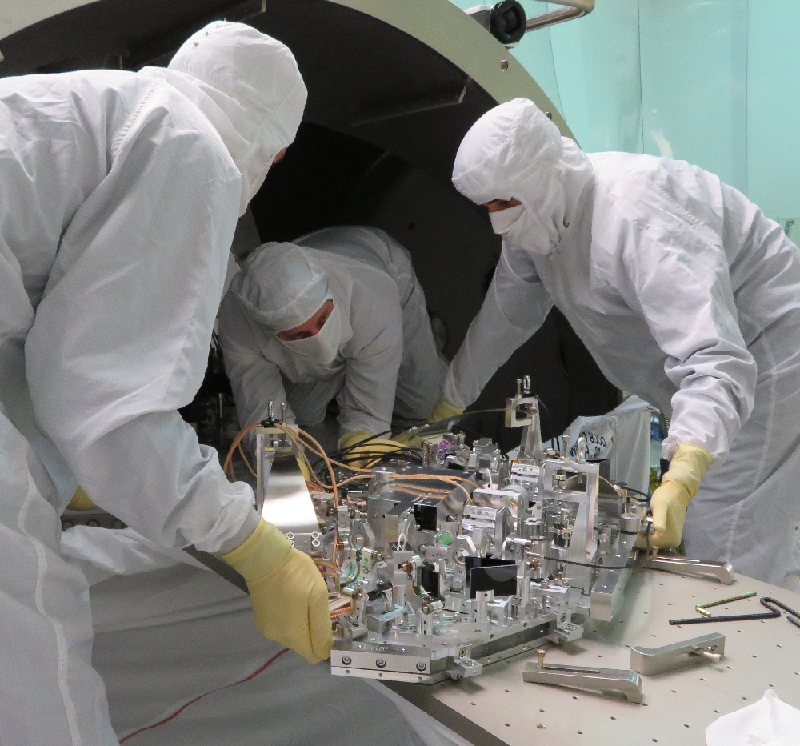Squeezing More from Gravitational-Wave Detectors
Since 2015, gravitational-wave detections have become routine in the two US-based Advanced LIGO instruments and in the Virgo detector in Italy, opening a new window in astronomy. The LIGO and Virgo collaborations have now demonstrated—in separate papers—a modification to their detectors that uses quantum physics to suppress random noise in the signal. The scheme improves the sensitivity of both instruments, which will boost the expected rate of detections by 20 to 50%.
Advanced LIGO and Virgo use interference of laser light bouncing back and forth along two perpendicular arms, 3–4 km long, to detect the spacetime ripples from a passing gravitational wave. The detector sensitivity—which corresponds to space distortions of close to 10−20 m—is limited by the effects of so-called quantum noise in the photons. Each photon in the light beam experiences quantum fluctuations, which affects its time of arrival after a round trip along the arms. “The photons arrive ‘on time’ at the detector on average, but some are very early and some are very late, forming a wide bell curve,” says Maggie Tse, a graduate student at the Massachusetts Institute of Technology (MIT), Cambridge, and a LIGO team member. The detectors are only sensitive to a gravitational wave if it changes the travel time in one arm by more than the width of this bell curve.
The LIGO and Virgo teams have reduced this noise using quantum squeezing—an idea first suggested nearly 40 years ago by quantum physicist Carlton Caves [1]. Quantum squeezing makes the arrival-time bell curve narrower, so that the photon fluctuations mask fewer of the gravitational-wave signals. A few prototype demonstrations have previously shown that squeezing can reduce noise in gravitational-wave detection [2, 3], and it has been used for several years at the GEO600 detector operated by the Albert Einstein Institute (AEI) in Germany [4].
To realize squeezing for the Advanced LIGO and Virgo projects, the teams incorporated several lessons from those earlier experiments. In both detectors, the heart of the squeezer is an optical parametric oscillator. This device produces pairs of photons that are entangled so that when one is “early” by a certain amount, the other is “late” by almost the same amount. These correlated photons are injected into the path of the main laser beam, after which the merged light is split in two, with each of the resulting beams being sent along one arm of the device. Once prepared in this way, the beams in the two arms are correlated, and their noise is reduced. “The underlying physical process used to generate the squeezed states is the same for Virgo and LIGO,” says Henning Vahlbruch, a member of the AEI team that worked with the Virgo Collaboration.
One challenge is that squeezing is no free lunch. Because of Heisenberg’s uncertainty principle, “when we squeeze the distribution of photon arrival times, something else must be becoming more uncertain,” says Tse. In this case, the number of photons striking the mirror at a given time becomes more random, leading to an increase in so-called quantum radiation pressure noise. The tradeoff is worth it for now, says Tse, because the radiation pressure effect is only noticeable at low frequencies. Nevertheless, this other source of noise can also limit the instrument sensitivity, which is why the LIGO researchers are now working on building a low-frequency filter, which they expect to be installed at the LIGO sites in the next few years. A similar modification is planned for Virgo.
For now, squeezing enhanced the sensitivity of the instruments significantly during the third observing run, which started in April of this year. “We can now detect sources that are about 15% further away for the average binary neutron star system,” says LIGO team member Lisa Barsotti from MIT. This means that “the number of sources we expect to detect has increased by about 50%.” The Advanced Virgo detector, meanwhile, increased its range by a little less: about 5–8% for binary neutron stars, giving a detection-rate boost of 16–26%.
Barsotti adds that, thanks to such improvements, the next major LIGO upgrade should increase the detection rate by more than a factor of 5. Moreover, squeezing specifically boosts the sensitivity to high-frequency gravitational waves, which should help in pinpointing the location of wave sources in the sky. This directional information allows astronomers to do follow-up observations in which they look for electromagnetic signals from events that produce gravitational waves.
Gravitational astrophysicist Kirk McKenzie of the Australian National University in Canberra says the results represent “a new era for gravitational-wave detectors.” Such quantum engineering, he says, has now “crossed from being a theoretical improvement to a tool to detect black-hole mergers further out in the universe than ever before.”
Astrophysicist Katerina Chatziioannou of the Flatiron Institute in New York says the improvements made by the two groups might enable us to see gravitational-wave signals from entirely new types of sources, such as supernovae or remnant stars created in binary neutron star collisions.
This research is published in Physical Review Letters.
–Philip Ball
Philip Ball is a freelance science writer in London. His latest book is How Life Works (Picador, 2024).
References
- C. M. Caves, “Quantum-mechanical radiation-pressure fluctuations in an interferometer,” Phys. Rev. Lett. 45, 75 (1980).
- J. Abadie et al. (The LIGO Scientific Collaboration), “A gravitational wave observatory operating beyond the quantum shot-noise limit,” Nat. Phys. 7, 962 (2011).
- J. Aasi et al., “Enhanced sensitivity of the LIGO gravitational wave detector by using squeezed states of light,” Nat. Photon. 7, 613 (2013).
- H. Grote, K. Danzmann, K. L. Dooley, R. Schnabel, J. Slutsky, and H. Vahlbruch, “First long-term application of squeezed states of light in a gravitational-wave observatory,” Phys. Rev. Lett. 110, 181101 (2013).







